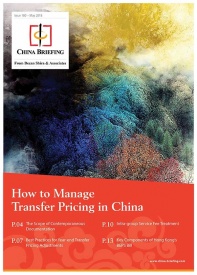Best Practices for Year-end Transfer Pricing Adjustments in China
By Dezan Shira & Associates
Author: Shirley Chu
Editor: Qian Zhou
Tax professionals at multinational companies (MNCs) often review their related party transactions at the end of the fiscal year. This helps them see whether the related party transactions within the group are in line with the arm’s length principle, and whether they meet the transfer pricing regulations where they operate.
When deviations are found in the review, professionals will voluntarily make precautionary adjustments to minimize the risk of being investigated by the tax authorities. This is called transfer pricing year-end adjustment.
Why year-end adjustments are needed
There are many reasons why a company’s operation might fall outside of the arm’s-length range. In most cases, it is neither deliberate nor an oversight.
The BEPS Action Plan has encouraged increased transfer pricing scrutiny from tax officials across the world. This, in turn, has encouraged MNCs to pay more attention to transfer pricing compliance. Accordingly, most MNCs regularly conduct transfer pricing analysis to develop systematic transfer pricing strategies at the group level. This helps ensure that transactions between related parties can obtain reasonable profits without violating the arm’s length principle or country-specific transfer pricing rules.
However, in actual practice, many legitimate factors that may cause a company’s final profit level to deviate from the arm’s length results. For example, the profit level of an enterprise can change quickly, causing an unexpected deviation, following market fluctuations. While internal procedures can always be tightened to improve responsiveness, the deviation may still bring potential transfer pricing risks to the company that necessitate adjustments.
A failure to respond to deviations carries stringent consequences, including special tax investigations, costly special tax adjustments (large taxation adjustments, additional fines, and interest payments), as well as stricter monitoring from the tax authorities.
Given these consequences, many MNCs opt to review and adjust their transfer pricing results periodically, ideally on a monthly or quarterly basis. While this practice helps mitigate risks, it is associated with operational challenges.
An MNC that wants to maintain up-to-date transfer pricing information must be prepared to coordinate information requirements across multiple departments and often multiple offices. This increased level of communication is difficult to achieve and maintain; year-end adjustments may become necessary to account for any deviations.
Given these circumstances, and the additional costs created by a more responsive transfer pricing postures, many MNCs treat periodic transfer pricing evaluations with priority and year-end adjustments as an important safeguard. These approach significantly reduces an MNC’s exposure to transfer pricing risks brought about by market or business variables.
![]() RELATED: The Scope of Contemporaneous Documentation in China
RELATED: The Scope of Contemporaneous Documentation in China
How to make TP year-end adjustment
Generally, MNCs employ third party professionals to assist in making year-end adjustments. Third party professionals are well-placed to independently assess deviations in transfer pricing execution results, and objectively calculate the amount that should be adjusted based on proper transfer pricing methods.
Beyond these basic concerns, third party professionals can advise the most practical methods for achieving the adjustments based on an MNC’s scope and situation. While the year-end adjustment is ultimately carried out by the internal financial team, third party advisory often saves time and resources while executing an adjustment.
Self-adjustment method
One method commonly used by MNCs with a subsidiary in China is voluntarily adjustments during the annual tax return. Enterprises often do this when it faces a high risk of being assessed as suffering “unreasonable” losses in related party transactions. This is commonly referred to as self-adjustment method or voluntary adjustment method.
The legal basis of this method can be found in Article 3 of “Announcement on Promulgation of the Administrative Measures on Special Tax Investigation, Adjustment and Mutual Agreement Procedure” (State Administration of Taxation (SAT) Announcement [2017] No. 6, Circular 6). Circular 6 stipulates, “if the company receives special tax adjustment risk warnings, or finds that there is a special tax adjustment risk, it can adjust the tax on its own.”
Under this method, an enterprise needs to complete a Voluntary Tax Payment Form for Special Tax Adjustment and submit it to the tax authorities. Later, during tax return season, the taxpayer needs to increase their taxable income in the Tax Adjustment Schedule.
![]() RELATED: Hong Kong’s New Transfer Pricing Regime
RELATED: Hong Kong’s New Transfer Pricing Regime
Enterprises need to be aware that simply making voluntary transfer pricing adjustments does not necessarily protect them from special tax investigations or further adjustments. If the enterprise has not made an adequate adjustment, the tax authorities may order an investigation and impose further special tax adjustments.
The importance of accurately evaluating profit deviation and the adjustment amount is therefore mission-critical for enterprises using self-adjustment method.
Enterprises need to be aware of one further challenge associated with self-adjustment method in China: only one party can make a one-sided increase in income tax; that means it’s very hard for another party to make a corresponding decrease. The consequence for MNCs is the risk of double taxation.
Credit and debit note adjustment method
Enterprises based in the US or EU often make year-end transfer pricing adjustments directly through the credit and debit note adjustment method. This allows both parties in a related transaction to make an appropriate year-end adjustment, and foreign headquarters commonly recommend it to their Chinese subsidiaries.
While it’s efficient and straightforward, it’s nearly impossible to achieve in China.
China’s tight foreign exchange controls make it difficult for Chinese subsidiaries to use this method. The foreign exchange controls prevent China-based subsidiaries from transferring out or receiving the corresponding foreign exchange amount in the name of the credit and debit notes adjustment. This is because credit and debit note adjustments can’t be matched against receipt and payment terms regulated by foreign exchange controls.
Best practices for developing a policy
There is no fail-safe or risk-free year-end adjustment method. Enterprises need to devote time and resources into studying local transfer pricing rules and practices for their China-based subsidiaries. This can inform a strong transfer pricing policy that helps limit the potential for regulatory risk or costly failure.
A safety first approach makes a big difference.
Enterprises that ensure pricing terms are in line with the arm’s length principle protect themselves significantly, while transfer pricing policies that leave extra room for future adjustments also help.
Enterprises should also consider adding more explanation notes to relevant clauses of the related party transaction agreements to help ensure compliance.
![]() Transfer Pricing Solutions from Dezan Shira & Associates
Transfer Pricing Solutions from Dezan Shira & Associates
Enterprises that design and establish an effective internal control system for transfer pricing improve the responsiveness and resilience of their transfer pricing regimes. Internal control systems strengthen the daily management and monitoring of transfer pricing operations, and help to avoid large, unexpected adjustments at the year-end.
There is no one tried and true method that enterprises can apply to all year-end adjustments. Enterprises need assess deviations from the arm’s length principle on a case-by-case basis to choose the most suitable method.
A strong internal control system for transfer pricing is particularly important given the number of government bureaus that can become involved. Year-end adjustments affect corporate income tax, custom duties, surcharges, accounting, and foreign exchange. Enterprises need to ensure that their policies and practices are in compliance with the bureaus that oversee these functions.
 This article is adapted from “How to Manage Transfer Pricing in China.” In this issue of China Briefing magazine, we offer foreign investors a practical guide to navigating the new transfer pricing regime in China as well as an introduction to major changes happening in Hong Kong.
This article is adapted from “How to Manage Transfer Pricing in China.” In this issue of China Briefing magazine, we offer foreign investors a practical guide to navigating the new transfer pricing regime in China as well as an introduction to major changes happening in Hong Kong.
About Us
China Briefing is produced by Dezan Shira & Associates. The firm assists foreign investors throughout Asia and maintains offices in China, Hong Kong, Indonesia, Singapore, Russia, and Vietnam.. Please contact info@dezshira.com or visit our website at www.dezshira.com.
- Previous Article Shenzhen Housing Fund: Maximum Contribution Limit Lowered
- Next Article US Businesses in China Optimistic Despite Trade War























